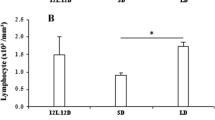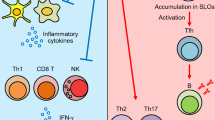Abstract
Seasonal variation in behavior and physiology, including changes in immune function, are common. This variability is elicited by changes in photoperiod and often covaries with fluctuations in both energy reserves and reproductive state. It is unclear, however, whether changes in either variable alone drive seasonal changes in immunity. We investigated the relative contributions of reproduction and energy balance to changes in immune function. To accomplish this, we uncoupled seasonal changes in reproduction from those related to energy balance via daily injections of N-methyl-d-aspartate (NMDA) in Siberian hamsters (Phodopus sungorus). NMDA is a glutamatergic agonist that blocks short day-induced gonadal regression, while leaving short-day declines in body mass unaffected. In Experiment 1, we examined the effect of differing doses of NMDA on testosterone production as a proxy for NMDA effects on reproduction; a dose-dependent rise in testosterone was observed. In Experiment 2, animals were maintained on long or short days and received daily injections of NMDA. After 8 weeks, all animals underwent a humoral immune challenge. Short-day animals receiving daily injections of NMDA maintained long day-like gonads; however, contrary to our predictions, no trade-off between reproduction or energy balance and immune function was observed. Unexpectedly, NMDA treatment increased immunoglobulin levels in all groups, suggesting that NMDA may provide an immunomodulatory signal, presumably through actions on peripheral glutamate receptors. These results support a previous finding that NMDA blocks reproductive regression. In addition, these findings demonstrate a general immunoenhancing effect of NMDA that appears independent of changes in reproductive or energetic state of the animal.



Similar content being viewed by others
References
Baker JR (1938) The evolution of breeding seasons. In: DeBeer GB (ed) Evolution: essays on aspects of evolutionary biology. Clarendon Press, Oxford, pp 161–177
Bartness TJ, Wade GN (1985) Photoperiodic control of seasonal body weight cycles in hamsters. Neurosci Biobehav Rev 9:599–612
Bartness TJ, Hamilton JM, Wade GN, Goldman BD (1989) Regional differences in fat pad responses to short days in Siberian hamsters. Am J Physiol Regul Integr Comp Physiol 257:1533–1540
Beery AK, Trumbull JJ, Tsao JM, Costantini RM, Zucker I (2007) Sex differences in the onset of seasonal reproductive quiescence in hamsters. Proc Roy Soc B Biol Sci 274:281–286
Bilbo S, Dhabhar F, Viswanathan K, Saul A, Yellon S, Nelson R (2002) Short day lengths augment stress-induced leukocyte trafficking and stress-induced enhancement of skin immune function. Proc Natl Acad Sci 99:4067
Bogdan C, Röllinghoff M, Diefenbach A (2000) Reactive oxygen and reactive nitrogen intermediates in innate and specific immunity. Curr Opin Immunol 12:64–76
Boldyrev AA, Kazey VI, Leinsoo TA, Mashkina AP, Tyulina OV, Johnson P, Tuneva JO, Chittur S, Carpenter DO (2004) Rodent lymphocytes express functionally active glutamate receptors. Biochem Biophys Res Commun 324:133–139
Brann DW, Mahesh VB (1997) Excitatory amino acids: evidence for a role in the control of reproduction and anterior pituitary hormone secretion 1. Endocr Rev 18:678–700
Bronson FH (1989) Mammalian reproductive biology. University of Chicago Press, Chicago
Carter C, Getz L, Gavish L, McDermott J, Arnold P (1980) Male-related pheromones and the activation of female reproduction in the prairie vole (Microtus ochrogaster). Biol Reprod 23:1038–1045
Cichon M, Dubiec A, Chadzinska M (2001) The effect of elevated reproductive effort on humoral immune function in collared flycatcher females. Acta Oecol 22:71–76
Dawson A, King VM, Bentley GE, Ball GF (2001) Photoperiodic control of seasonality in birds. J Biol Rhythm 16:365–380
Deerenberg C (1997) Reproductive effort decreases antibody responsiveness. Proc Roy Soc B Biol Sci 264:1021–1029
Demas GE (2002) Splenic denervation blocks leptin-induced enhancement of humoral immunity in Siberian hamsters (Phodopus sungorus). Neuroendocrinology 76:178–184
Demas GE (2004) The energetics of immunity: a neuroendocrine link between energy balance and immune function. Horm Behav 45:173–180
Demas GE, Chefer V, Talan MI, Nelson RJ (1997) Metabolic costs of mounting an antigen-stimulated immune response in adult and aged C57BL/6 J mice. Am J Physiol Regul Integr Comp Physiol 42:R1631–R1637
Demas GE, Drazen DL, Jasnow AM, Bartness TJ, Nelson RJ (2002) Sympathoadrenal system differentially affects photoperiodic changes in humoral immunity of Siberian hamsters (Phodopus sungorus). J Neuroendocrinol 14:29–35
Demas GE, Drazen DL, Nelson RJ (2003) Reductions in total body fat decreases humoral immunity. Proc Roy Soc B Biol Sci 270:905–911
Dixon F, Jacot-Guillarmod H, McConahey P (1966) The antibody responses of rabbits and rats to hemocyanin. J Immunol 97:350
Dluzen D, Ramirez V, Carter C, Getz L (1981) Male vole urine changes luteinizing hormone-releasing hormone and norepinephrine in female olfactory bulb. Science 212:573–575
Drazen DL, Kriegsfeld LJ, Schneider JE, Nelson RJ (2000) Leptin, but not immune function, is linked to reproductive responsiveness to photoperiod. Am J Physiol Regul Integr Comp Physiol 278:R1401–R1407
Drazen DL, Demas GE, Nelson RJ (2001) Leptin effects on immune function and energy balance are photoperiod dependent in Siberian Hamsters (Phodopus sungorus) 1. Endocrinology 142:2768–2775
Ebling FJP, Alexander IHM, Urbanski HF, Hastings MH (1995) Effects of N-methyl-d-aspartate (NMDA) on seasonal cycles of reproduction, body weight and pelage color in the male Siberian hamster. J Neuroendocrinol 7:555–566
French SS, DeNardo DF, Moore MC (2007) Trade-offs between the reproductive and immune systems: facultative responses to resources or obligate responses to reproduction? Am Nat 170:79
Goldman BD (2001) Mammalian photoperiodic system: formal properties and neuroendocrine mechanisms of photoperiodic time measurement. J Biol Rhythms 16:283–301
Hoffmann K (1973) Influence of photoperiod and melatonin on testis size, body weight, and pelage color in Djungarian hamster (Phodopus sungorus). J Comp Physiol 85:267–282
Julius MH, Masuda T, Herzenberg LA (1972) Demonstration that antigen-binding cells are precursors of antibody-producing cells after purification with a fluorescence-activated cell sorter. Proc Natl Acad Sci 69:1934–1938
Kliman RM, Lynch GR (1992) Evidence for genetic variation in the occurrence of the photo response of the Djungarian hamster, Phodopus sungorus. J Biol Rhythms 7:161–173
Kostanyan IA, Merkulova MI, Navolotskaya EV, Nurieva RI (1997) Study of interaction between l-glutamate and human blood lymphocytes. Immunol Lett 58:177–180
Levite M (2001) Nervous immunity: neurotransmitters, extracellular K+ and T-cell function. Trend Immunol 22:2–5
Lombardi G, Dianzani C, Miglio G, Canonico PL, Fantozzi R (2001) Characterization of ionotropic glutamate receptors in human lymphocytes. Br J Pharmacol 133:936–944
Lynch GR, Lynch CB (1986) Seasonal photoperiodism in the Djungarian hamster—a genetic component influences photoresponsiveness. Behav Genet 16:625–626
Martin LB, Scheuerlein A, Wikelski M (2003) Immune activity elevates energy expenditure of house sparrows: a link between direct and indirect costs? Proc Roy Soc Lond Ser B Biol Sci 270:153–158
Martin LB, Weil ZM, Nelson RJ (2008) Seasonal changes in vertebrate immune activity: mediation by physiological trade-offs. Philos Trans Roy Soc B Biol Sci 363:321–339
Maywood ES, Hastings MH (1995) Lesions of the iodomelatonin-binding sites of the mediobasal hypothalamus spare the lactotropic, but block the gonadotropic response of male Syrian hamsters to short photoperiod and to melatonin. Endocrinology 136:144–153
Mercer JG, Moar KM, Logie TJ, Findlay PA, Adam CL, Morgan PJ (2001) Seasonally inappropriate body weight induced by food restriction: effect on hypothalamic gene expression in male Siberian hamsters. Endocrinology 142:4173–4181
Miglio G, Varsaldi F, Lombardi G (2005) Human T lymphocytes express N-methyl-d-aspartate receptors functionally active in controlling T cell activation. Biochem Biophys Res Commun 338:1875–1883
Nelson RJ (2004) Seasonal immune function and sickness responses. Trend Immunol 25:187–192
Nelson RJ, Demas GE (1996) Seasonal changes in immune function. Q Rev Biol 71:511–548
Prendergast BJ, Kriegsfeld LJ, Nelson RJ (2001) Photoperiodic polyphenisms in rodents: neuroendocrine mechanisms, costs, and functions. Q Rev Biol 76:293–325
Prendergast BJ, Baillie SR, Dhabhar FS (2008) Gonadal hormone-dependent and -independent regulation of immune function by photoperiod in Siberian hamsters. Am J Physiol Regul Integr Comp Physiol 294:R384–R392
Reddy AB, Cronin AS, Ford H, Ebling FJP (1999) Seasonal regulation of food intake and body weight in the male Siberian hamster: studies of hypothalamic orexin (hypocretin), neuropeptide Y (NPY) andpro-opiomelanocortin (POMC). Eur J Neurosci 11:3255–3264
Steinlechner S, Heldmaier G, Becker H (1983) The seasonal cycle of body weight in the Djungarian hamster: photoperiodic control and the influence of starvation and melatonin. Oecologia 60:401–405
Tieleman BI, Williams JB, Ricklefs RE, Klasing KC (2005) Constitutive innate immunity is a component of the pace-of-life syndrome in tropical birds. Proc Roy Soc B Biol Sci 272:1715–1720
Wade GN, Bartness TJ (1984) Effects of photoperiod and gonadectomy on food intake, body weight, and body composition in Siberian hamsters. Am J Physiol Regul Integr Comp Physiol 246:26–30
Yellon S, Fagoaga O, Nehlsen-Cannarella S (1999a) Influence of photoperiod on immune cell functions in the male Siberian hamster. Am J Physiol Regul Integr Comp Physiol 276:97–102
Yellon SM, Teasley LA, Fagoaga OR, Nguyen HC, Truong HN, Nehlsen-Cannarella SL (1999b) Role of photoperiod and the pineal gland in T cell-dependent humoral immune reactivity in the Siberian hamster. J Pineal Res 27:243–248
Young KA, Zirkin BR, Nelson RJ (1999) Short photoperiods evoke testicular apoptosis in white-footed mice (Peromyscus leucopus) 1. Endocrinology 140:3133–3139
Zysling DA, Demas GE (2007) Metabolic stress suppresses humoral immune function in long day, but not short-day, Siberian hamsters (Phodopus sungorus). J Comp Physiol B 177:339–347
Acknowledgments
We would like to thank Lisa Garatoni, Laura Garman, Jill Lodde and Trevor Brown for expert animal assistance. This work was supported by an SICB Grant-in-Aid (T.J.G.), an NIH/T32 training grant HD049336-0 (T.J.G., S.S.F), an Eli Lilly METACyt grant, Indiana University Faculty Research Support Program and NSF IOB:0543798 (G.E.D).
Author information
Authors and Affiliations
Corresponding author
Additional information
Communicated by G. Heldmaier.
The authors T. J. Greives and S. S. French contributed equally to this work.
Rights and permissions
About this article
Cite this article
Greives, T.J., French, S.S., Zysling, D.A. et al. The glutamate agonist NMDA blocks gonadal regression and enhances antibody response to an immune challenge in Siberian hamsters (Phodopus sungorus). J Comp Physiol B 180, 267–277 (2010). https://doi.org/10.1007/s00360-009-0411-z
Received:
Revised:
Accepted:
Published:
Issue Date:
DOI: https://doi.org/10.1007/s00360-009-0411-z




